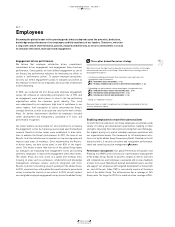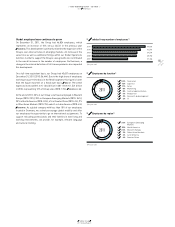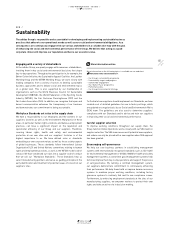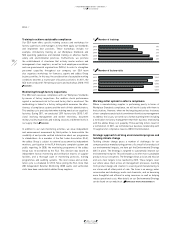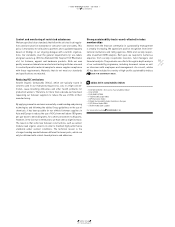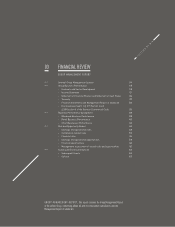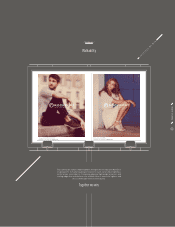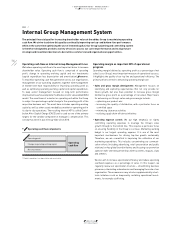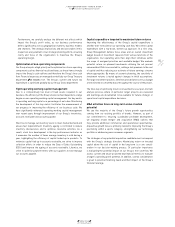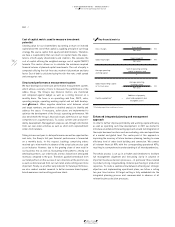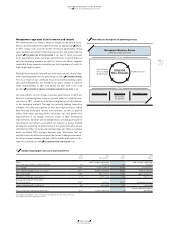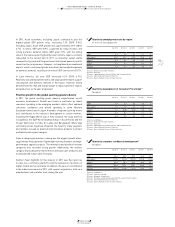Reebok 2011 Annual Report Download - page 113
Download and view the complete annual report
Please find page 113 of the 2011 Reebok annual report below. You can navigate through the pages in the report by either clicking on the pages listed below, or by using the keyword search tool below to find specific information within the annual report.
adidas Group
2011 Annual Report
GROUP MANAGEMENT REPORT – OUR GROUP
109
2011
02.8 Sustainability
Improving our environmental footprint at own sites
An important part of our Group’s Environmental Strategy is the Green
Company initiative, which targets reducing the environmental footprint
of our own sites. The initiative provides a supporting framework,
guidance and communication platform for all Group entities to
improve their environmental footprint.
As part of this initiative, we have set Group-wide and site-specific
2015 targets related to carbon emissions, savings in energy, water
and paper consumption as well as sourcing green energy. One of
the key goals within the Green Company initiative has been to obtain
ISO 14001 certification for environmental management systems
established at six major administration sites of the adidas Group. This
was already achieved for five major sites in 2010, all located in North
America (Portland, Carlsbad, Canton, Montreal and Spartanburg).
The certification of the adidas Group Headquarters site “World of
Sports” in Herzogenaurach, Germany, and our Distribution Centre in
Indianapolis, USA, was achieved in 2011.
Sustainable materials
One key goal of our Environmental Strategy is to reduce the overall
environmental impact of materials used in our products. We aim
to find materials that will reduce waste or have less of an impact
throughout their whole life cycle. The adidas Group has various
initia tives in place that help to achieve its goal to increase the
usage of sustainable materials. One example is the participation in
the Better Cotton Initiative which the adidas Group co-founded. We
are committed to using 100% Better Cotton by 2018 in all of our
products. Better Cotton can be described as sustainable cotton
going mainstream, i.e. decreasing negative impacts of growing
cotton by cutting water consumption considerably and addressing
pesticide management, crop rotation and sound working conditions.
In 2012, we will continue to launch products containing Better Cotton.
More information about Better Cotton can be found on our website
at :
WWW.ADIDAS-GROUP.COM/SUSTAINABILITY
.
One example of how sustainable materials, environmental design and
manufacturing are implemented is the adidas “Better Place” concept.
The adidas brand consolidates its sustainable product research and
development within this sustainable product creation programme. The
first adidas “Better Place” products were introduced globally in 2009
in response to increasing consumer demand for sustainable sports
apparel and footwear. The products feature environmentally innovative
design, construction, material composition and packaging that distin-
guish them as environmentally preferred. All materials that are used
for “Better Place” have to pass an in-depth assessment.
adidas reached a considerable milestone with all global footwear
products created in 2011 either reaching or exceeding the baseline
“Better Place” criteria. Along with strong performance in apparel, this
represents a considerable increase in “Better Place” products during
the year. This growth is supported by ongoing innovation in the area
of sustainable product construction and manufacturing techniques,
such as the zero-waste hot-runner injection technologies used on
several 2011 running footwear models. Hot runners are a technology
brought over from the automotive industry, where injectable materials
travel through a heated channel directly from the machine into the
mould, only using the amount of material needed, and resulting in no
production overflow from the mould. We see sizeable business oppor-
tunities for our Group in the area of sustainable product concepts
SEE RISK AND OPPORTUNITY REPORT, P. 145
, and have already planned increased
growth in the sustainable product segment as well as a rise in
consumer engagement in the topic for 2012.
Driving environmental improvements in our supply chain
In the supply chain, activities focus on helping suppliers establish
sound environmental management systems at their manufacturing
plants to best reduce their negative environmental impacts. We
have guidelines and training programmes in place for our suppliers,
using the environmental performance of our own production sites as
examples of best practice.
The majority of our footwear sourcing volume is produced in factories
which are OHSAS 18000 and/or ISO 14001 certified. The remaining
part of our footwear sourcing volume is produced in factories that
have management systems in place but have not been certified. All
footwear factories are regularly assessed against the adidas Group’s
standards on environment and workplace health and safety. A range of
other activities have been implemented to reduce our carbon footprint
in the supply and distribution chain. Examples of these are in the
areas of transportation and energy use. In the transportation of our
products, our policy is to minimise the impacts, in particular from air
freight shipments, through improved order and production planning
tools.




